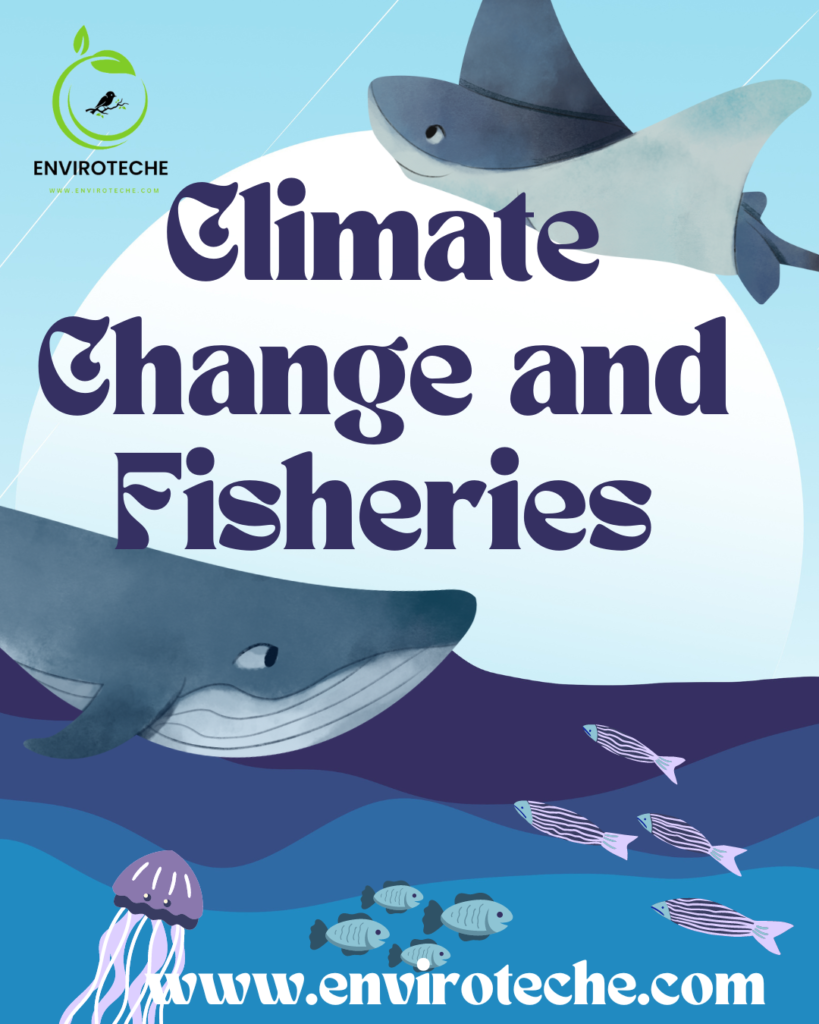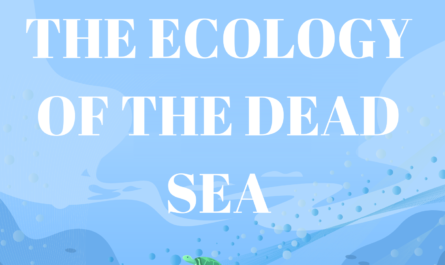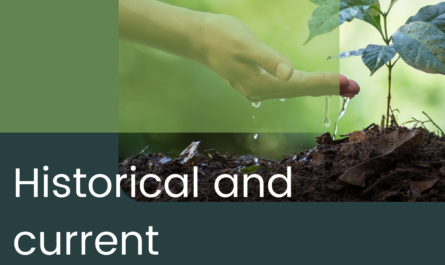
Climate Change and Fisheries
Affifa Naseer1
1Department of Zoology, University of Agriculture Faisalabad
Abstract:
Fisheries face tremendous problems as a result of the urgent worldwide issue of climate change. The goal of this in-depth review essay is to give a thorough overview of the many effects of climate change on fisheries. It examines the effects of changing precipitation patterns, ocean acidification, sea level rise, and rising temperatures on fish populations, aquatic ecosystems, fishing communities, and the world’s supply of seafood. The article also examines possible management techniques and adaptation measures to lessen the adverse impacts of climate change on fisheries.
Climate change Introduction:
Climate change, which has a major impact on numerous different ecosystems on our planet, is one of the most crucial concerns currently facing humanity (Piao et al., 2019). Our fisheries are one area where this phenomenon has a significant impact. Rising temperatures, acidification of the oceans, sea level rise, and altered precipitation patterns all threaten to upset the delicate equilibrium of marine ecosystems, with dire consequences for fish populations and those who rely on them (Breitburg et al., 2018).
This blog post will examine the complex relationship between fisheries and climate change, highlighting the difficulties encountered and potential solutions to protect this precious resource for coming generations.
Impact of climate change on Fish Habitats
Fish habitats are significantly impacted by climate change, with repercussions felt throughout entire ecosystems. By changing water temperatures and upsetting thermal regimes, rising global temperatures have a direct impact on aquatic ecosystems. For best growth, reproduction, and survival, many fish species have precise temperature requirements, and even little departures from these ideal ranges might be harmful. Some fish species may grow less quickly, have fewer offspring, and become more vulnerable to illnesses and parasites as temperatures rise (Ninawe et al., 2018).
As a result of shifting food availability and potential mismatches between predators and their prey, climate change may also affect the timing and availability of crucial fish food sources like plankton blooms or insect hatches. As a result of altered water availability and flow regimes, reduced spawning grounds, altered river and stream flows, and altered connectivity between various habitats, changes in precipitation patterns can have an influence on fish habitats. Because it may cause the inundation and loss of vital estuary and mangrove regions that many species depend on as nurseries and foraging grounds, sea-level rise poses a serious danger to coastal fish ecosystems. Moreover, fish and other marine species suffer from ocean acidification, which is brought on by the seawater’s absorption of too much carbon dioxide. Acidification can interfere with fish’s capacity to develop and maintain their skeletons as well as their ability to perform their sensory and neurological processes.
Overall, the consequences of climate change on fish habitats are extensive, and they may result in population decreases, changes in species composition, and disruptions of entire ecosystems, which may have repercussions for other types of animals and human societies that depend on robust fish populations.
Ocean Acidification
In addition to contributing to global warming, rising atmospheric CO2 levels also cause ocean acidification. Seawater’s pH is lowered as a result of increased carbon dioxide dissolving in it, increasing its acidity. Ocean acidification is a process that takes place when atmospheric carbon dioxide (CO2) dissolves in saltwater, causing the pH of the ocean to drop. With the pH dropping, the water becomes more acidic, which can have a big impact on marine ecosystems and the fish and food chain that depend on them.
When CO2 dissolves in seawater, water molecules react with it to create carbonic acid. The pH of the water is decreased as a result of this reaction’s increase in hydrogen ions (H+) concentration. The amount of CO2 that is being absorbed by the oceans has significantly increased as a result of human activities like the burning of fossil fuels that release CO2 into the atmosphere. Fish and other marine species may be impacted both directly and indirectly by the acidity of seawater (Prakash, S. (2021). Some fish species have immediate physiological reactions to pH variations, including changed metabolic rates, hampered growth, diminished immunological function, and hampered sensory systems. The growth and survival of fish eggs and larvae can also be impacted by acidity, which can impede recruitment and cause population losses.
Ocean acidification may indirectly affect the quantity and caliber of fish food sources. Many marine animals contain calcium carbonate shells or structures that can disintegrate in more acidic environments. This includes small planktonic species like phytoplankton and zooplankton. Because they serve as the main source of food for numerous fish species, these organisms are essential to the marine food chain. Fish availability diminishes with the fall of their populations, which could affect the fish quantity, distribution, and behavior. Furthermore, the physiology and behavior of prey creatures can be affected by ocean acidification. According to some research, for instance, increased acidity can make it harder for prey fish to spot predators, making them more vulnerable to exploitation.
Overall, the marine food system, including fish populations, is seriously threatened by ocean acidification. It is difficult to foresee the precise effects due to the intricate interactions and cascading effects within the ecosystem. However, it is evident that the health and stability of marine ecosystems and the fish species that depend on them might be significantly impacted by prolonged acidification of the seas.
Changes in Ocean Currents and Upwelling
The upwelling and ocean circulation changes have a big effect on fish populations. The distribution and number of fish species are influenced by the movement of nutrients, oxygen, and temperature across the ocean, which is accomplished by ocean currents. The delicate equilibrium of marine ecosystems can be upset by changes in current patterns, such as changes in intensity, direction, or variability. The productivity of coastal areas depends on upwelling, which is the upward flow of nutrient-rich deep water toward the surface. Upwelling promotes the growth of phytoplankton, which is the main food source for many fish species. Reduced phytoplankton blooms can have an effect on the entire food chain and thus affect the availability of prey for fish as a result of changes in upwelling patterns, such as decreased intensity or altered timing. The distribution, abundance, and even migration patterns of fish may vary as a result of these changes in ocean currents and upwelling, with possible knock-on impacts on fisheries, marine ecosystems, and the way of life of coastal people who depend on fish as a crucial resource (Kämpf, J., & Chapman, P. (2016).
Overfishing and Climate Change
Throughout the world, marine ecosystems are seriously threatened by overfishing and climate change. The overfishing of fish populations, the disruption of food chains, and the alteration of the equilibrium of marine ecosystems are all caused by excessive and unsustainable fishing methods. This endangers the stability and resilience of marine ecosystems in addition to threatening the livelihoods of millions of people who depend on fisheries for food and a living. Furthermore, by raising marine temperatures, changing ocean currents, and making seawater more acidic, climate change makes these problems worse. The natural habitats and reproductive cycles of marine species are disrupted by these changes, which causes additional decreases in fish populations. As damaged ecosystems are less able to tolerate the effects of climate change, the interaction between overfishing and climate change results in a negative feedback loop. Through sustainable fishing methods, the creation of marine protected areas, and international initiatives to cut greenhouse gas emissions and ameliorate the impact of climate change on our seas, immediate action is required to address simultaneously overfishing and climate change (Sumaila et al., 2020).
Conclusion
Fisheries around the world are facing tremendous challenges due to climate change. The long-term viability and productivity of fish populations are threatened by habitat destruction, ocean acidification, changing currents, and the compounding impacts of overfishing. But we can work to protect our fisheries for future generations by applying adaptive management measures, embracing sustainable fishing methods, and cutting greenhouse gas emissions. In order to provide effective solutions and promote healthy cohabitation between people and the marine environment, it is crucial to understand the complex interaction between climate change and fisheries.
References:
Piao, S., Liu, Q., Chen, A., Janssens, I. A., Fu, Y., Dai, J., … & Zhu, X. (2019). Plant phenology and global climate change: Current progresses and challenges. Global change biology, 25(6), 1922-1940.
Breitburg, D., Levin, L. A., Oschlies, A., Grégoire, M., Chavez, F. P., Conley, D. J., … & Zhang, J. (2018). Declining oxygen in the global ocean and coastal waters. Science, 359(6371), eaam7240.
Ninawe, A. S., Indulkar, S. T., & Amin, A. (2018). Impact of climate change on fisheries. In Biotechnology for Sustainable Agriculture (pp. 257-280). Woodhead Publishing.
Prakash, S. (2021). Impact of Climate change on Aquatic Ecosystem and its Biodiversity: An overview. International Journal of Biological Innovations, 3(2).
Kämpf, J., & Chapman, P. (2016). Upwelling systems of the world (pp. 31-42). Springer International Publishing Switzerland.
Sumaila, U. R., & Tai, T. C. (2020). End overfishing and increase the resilience of the ocean to climate change. Frontiers in Marine Science, 7, 523.
Read Other Scientific Information:

